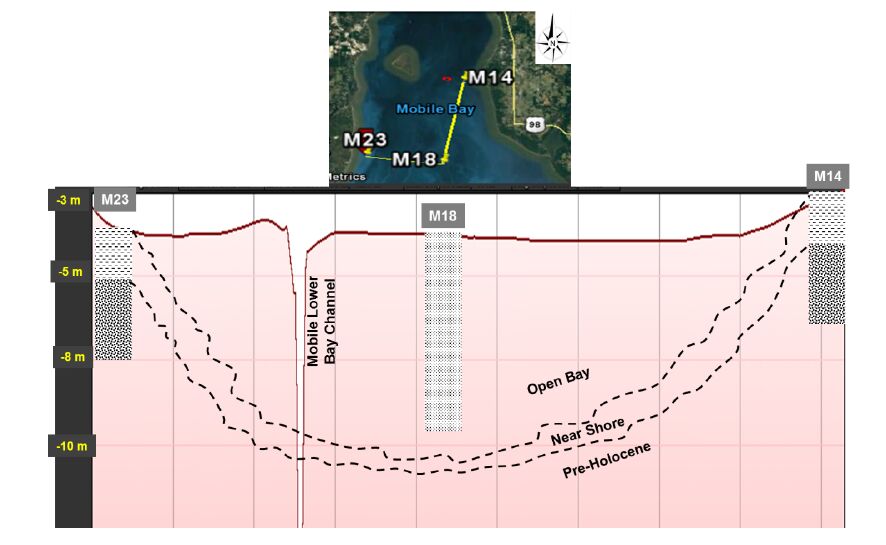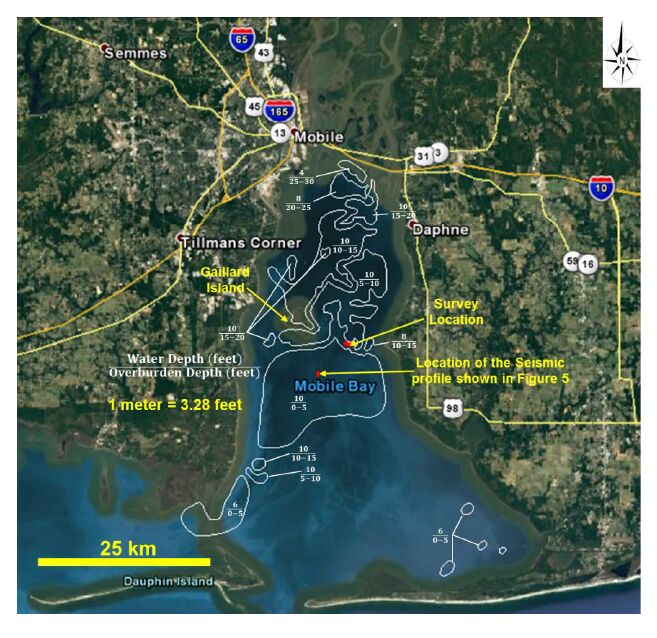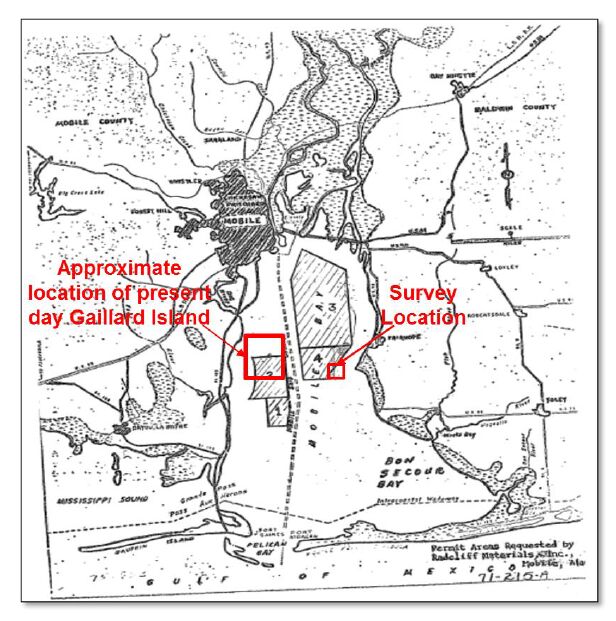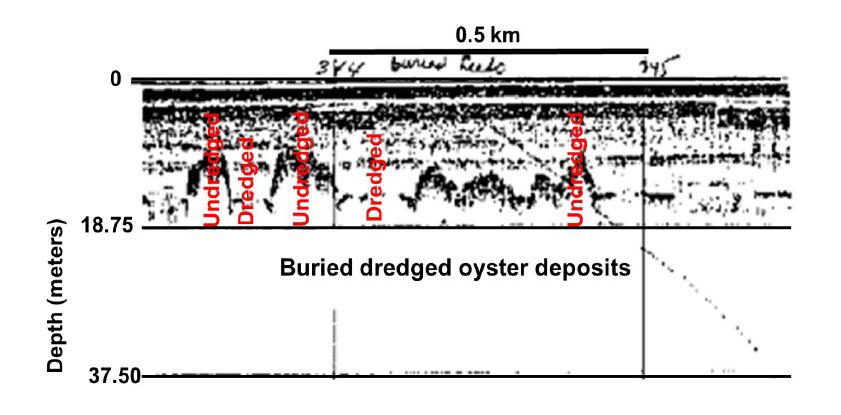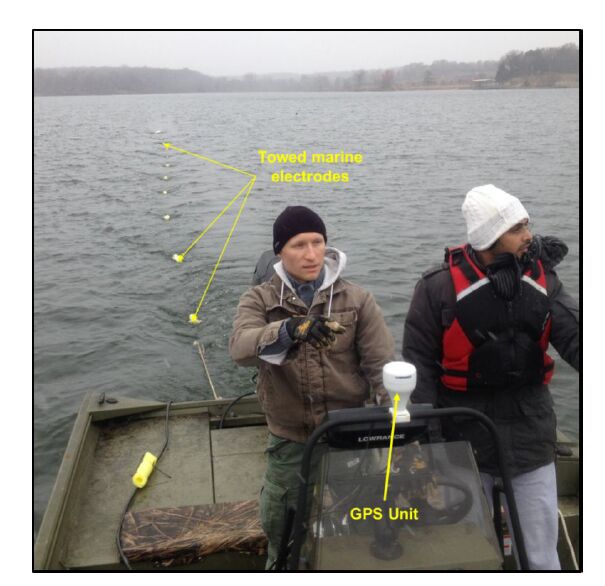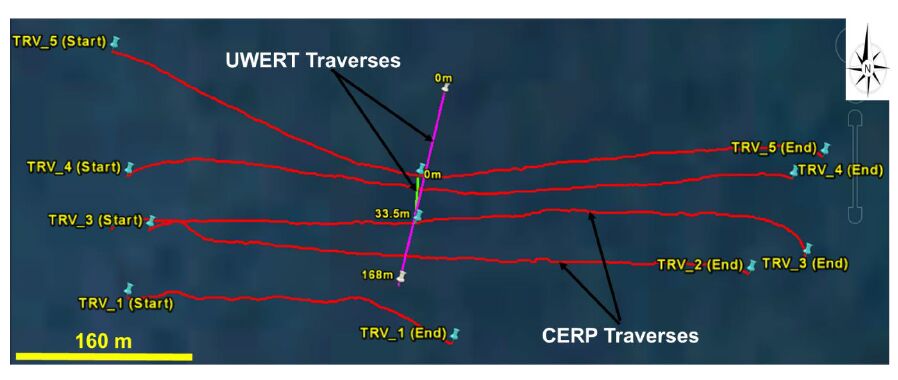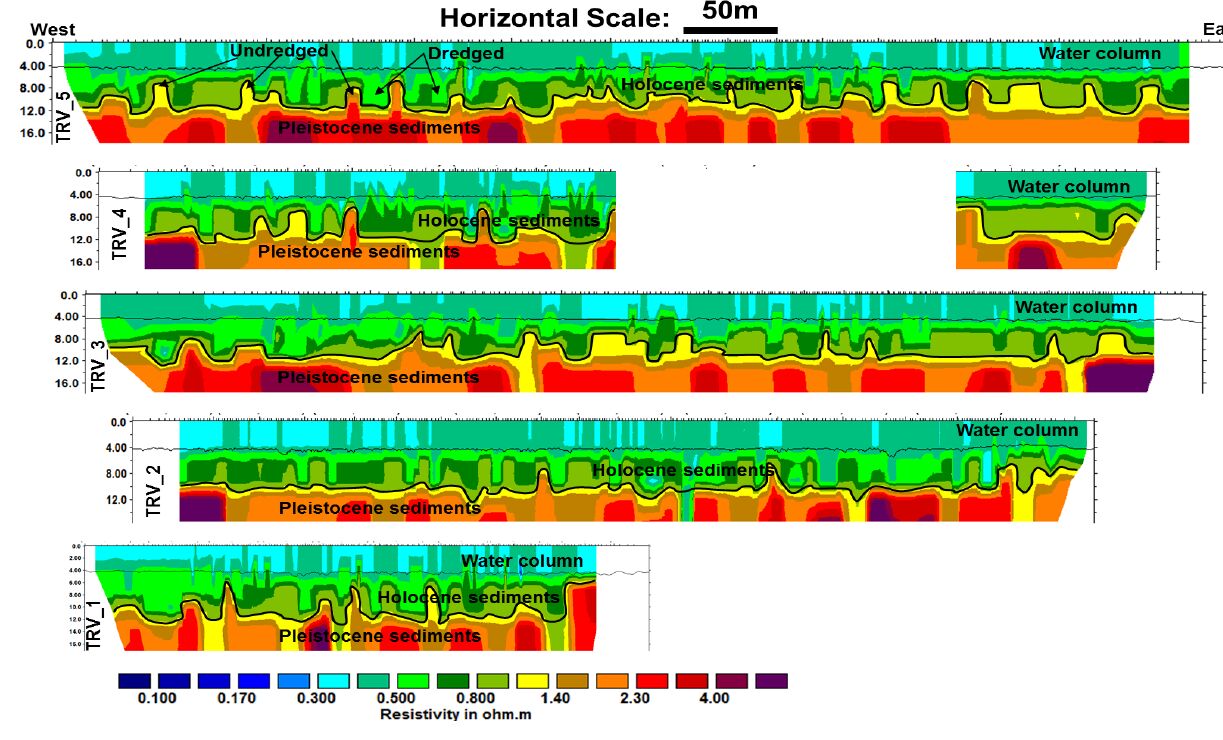1. Introduction
Gaillard Island (a man-made island located northwest of Mobile Bay, Alabama) was constructed by the United States Army Corp of Engineers (USACE) in 1979 to provide a cost effective and environmentally friendly means of disposing dredged materials removed from the Theodore Channel and Mobile Bay Upper Channel (Figure 1). The island is still an active disposal site for dredged materials from the mobile bay shipping channel however, it is expected to attain its regulatory capacity in the near future. Hence, there is need to consider other options for disposing materials dredged ship channels. One possible option is to deposit these materials into the naturally infilled but undercompacted scour features created by oyster shell dredging operations by Radcliff Materials Inc. between 1946 and 1982 in Mobile Bay [1,2]. If the existing infill materials are indeed significantly undercompacted, significant volumes of excavated channel material could be placed in the scour features. Hence, there is need to map the scour features created by oyster dredging so that the characteristic (lithology, density, etc.) of the natural fill materials can be identified and suitability of these features as sites for the placement of materials dredged from the shipping channels determined.
Over the years, various geophysical methods have been used by different authors for the delineation of marine sub bottom stratigraphy. Teatini demonstrated the use of electrical resistivity tomography, airborne electromagnetic and the sub bottom profiling tools in the mapping of the stratigraphy units of the southern area of the Venice Lagoon [3], Italy. Similarly, Vardy et al., in 2010 used the sub bottom profiling tool to map the stratigraphy of Lake Windermere, UK. These studies support the increasing demand for the use of geophysical tools for the delineation of marine stratigraphic units [4].
To identify and map scour features created by the dredging for oyster shells, electrical resistivity tomography (ERT) data were acquired along multiple near parallel traverses east of the Gaillard Island where oyster shells had been dredged in the past for commercial purposes.
2. Geologic Background of Mobile Bay, Alabama
Mobile Bay is the 4th largest estuary in the United States [5] with an average discharge of about 17,500 m3 cubic meters of water per second (Figure 1). The Mobile and Tensaw Rivers feed the Bay from the North, the Fish River feeds the Bay from the East, while the Dog, Deer and Fowl Rivers feed the Bay from the West. Mobile Bay covers about 1070 km2 in area. It is about 50 km in length with a maximum width of 39 km. The depth of the bay outside of a shipping channel is typically about 3 m; within a shipping channel depths reach 23 m.
Mobile Bay is an incised fluvial valley [6,7]. This process involves the rapid erosion of sediments by rivers as a result of the lowering of the sea level during the last glacial age. The created valley has been filled by sediment as a result of the subsequent rise in sea level.
Most of the terrigenous clastics found in Mobile Bay are silty clay and clayey silt [5]. According to the authors, clean water bottom sands are mainly found in shallow water near the external boundaries of the bay; elsewhere the bay bottom normally consists of silty clay sediment. A cross-section of Mobile Bay relative to the survey location is shown in Figure 2. Mars suggests that the stratigraphy of the central part of the bay is such that in which the Open Bay sediments overlies the Near Shore sediments which in turn overlies the Pre-Holocene sediments [8]. The authors described the Open Bay sediments as comprising of mainly silty clay and clayey silt materials with small mud pockets, clay pockets and burrow traces. The Open Bay sediments thickens from the bay margins to the center and baywards. The Near Shore sediments consists of sandy mud and muddy sand.
The distribution of buried oyster deposits in Mobile Bay is shown in Figure 3. These oyster reefs and beds formed after the last glacial period. May (1971) and Mars et al. (1992) conclude that oysters older than 6000 years before present (BP) has not been found in the bay. The buried oyster beds are found beneath about 8m overburden of post-glacial silty clay in the northern part of the bay and beneath thin overburden of silty clays (less than one meter), in the southern part of the bay [7]. The author also stated that commercially dredged oyster deposits in the bay do not extend beyond 11 meters below sea level, however suggesting that the oyster deposits could extend deeper at the bay-head on the Pleistocene surface.
2.1. History of Buried Oyster Bed Dredging in Mobile Bay, Alabama
Apart from the dredging of the shipping channels in Mobile Bay, Alabama, other extensive dredging operations have been conducted in the bay over the past hundred years. Between 1946 and 1982, buried oyster shell deposits were dredged from Mobile Bay for different commercial purposes such as concrete, road construction, chemicals and the manufacture of poultry feeds [1,2]. The permitted dredging areas in the bay based on the permits issued in 1973 are shown in Figure 4.
May (1971) reports that Radcliff Materials Inc. (the primary oyster dredging company in Mobile Bay at the time) utilized hydraulic cutter head dredge method for the dredging of the oyster deposits from the bay. It was estimated that about 30 million cubic meters of oyster shell were extracted by Radcliff Materials Inc. from the bay between 1947 and 1968, May (1971).
It was reported that the dredge had a discharge box on its tail as part of its design to refill the dredge cuts with the remnants of the dredged material after the oyster shells had been extracted. It was reported that this refilling was not very efficient as subsequent surveys about one year after a dredging operation still revealed unfilled dredge cuts [2]. Hence, it is believed that most of the dredge cuts filled naturally over time, probably with undercompacted silty clays.
A seismic section collected from Mobile Bay, just south east of Gaillard Island is shown in Figure 5. The figure shows locations of dredged and undredged oyster shell deposits.
3. Methods
The underwater electrical resistivity tomography (UWERT) and continuous electrical resistivity profiling (CERP) geophysical tools were used in this investigation. These two electrical resistivity tomography tools measure variations in the resistivity of the subsurface which are related to the moisture content, salinity, clay content, porosity, permeability and other electrical properties of subsurface materials, hence, subsurface materials such as clay, sand and rock with varying electrical properties can often be differentiated.
The acquisition of CERP data is shown in Figure 6. The CERP dipole-dipole array consists of eleven electrodes logging in continuously during data acquisition. The first two electrodes directly behind the boat serve as current electrodes; the remaining 9 electrodes are the potential electrodes. An echo sounding unit (typically equipped with a GPS) is used to simultaneously collect water depth and survey control along survey traverses.
The UWERT survey involves stretching and submerging the electrodes at the bottom of water and acquiring the data in static mode. GPS and water depth data are subsequently collected along the ERT transects.
3.1. ERT Data Acquisition and Processing
3.1.1. Continuous Electrical Resistivity Profiling
CERP data were collected at the survey location along near parallel west-east orientations as shown in Figure 7. The data was collected using eleven 20 feet (~6 meters) spaced streaming electrodes. The spacing was considered to be sufficient to image about 4 to 4.5 m of water depth expected at the survey location and additional 6-9 m of sub bottom materials. The Advanced Geosciences Inc. (AGI) Supersting resistivity meter was used for this survey [9]. During the CERP survey, a unit by Lowrance [10] was used to log both GPS and water depth data along the traverses at the same time.
The acquired CERP data was preprocessed using the AGI's Marine Log Manager Software (reference). The software allows the user to digitize the map covering the survey location and to combine the GPS/water depth file with streamed resistivity measurements. The data was subsequently linearized and exported into an inversion-compatible format for further processing.
The exported data was further converted from .STG format to .DAT format which is compatible for running the inversion using the RES2DINV software by Geotomo Software [11]. The depth profile was inserted into the .DAT file as well as the corresponding UTM coordinates. The data was then inverted using finite element inversion algorithm in Res2DInv processing software after selecting suitable inversion parameters.
3.1.2. Under Water Electrical Resistivity Tomography
A 33.5-meter-long (with ~0.6 meter spaced electrodes) UWERT profile was acquired at the survey location (see Figure 7). The orientation of the UW ERT traverse was north-west. The data was acquired using the Wenner-Schlumberger electrode array type. The ~0.6 meter electrodes spacing used was to obtain high resolution image of the shallow sub bottom.
An additional 168-meter-long (with 3 meter spaced electrodes) UWERT profile was acquired at the survey location. This profile partially overlaps the 33.5-meter-long UWERT profile (see Figure 7). This profile was acquired using the Wenner-Schlumberger electrode array also.
GPS and depth data were inserted into the converted .DAT file and processed using the RES2DINV software after applying necessary processing parameters.
4. Results and Discussion
The results of the geophysical investigation are presented below. The implications of the results are also presented. The 5 CERP profiles are shown in Figure 8. The 33.5 m and 168 m long UWERT profiles are also shown in Figures 9 and 10 respectively.
Water resistivity and temperature measured during the survey at the survey location was 0.4 ohm.m and 86 oF respectively. Based on these two values, the water salinity was calculated to be approximately 16,000 PPM (parts per million).
Resistivity values of 0.1 to 0.6 ohm-m were used to characterize silty-clay sub bottom sediments; resistivity values between 0.6 and 1.1 ohm-m were used to characterize unconsolidated dredge fill and clayey silty sediments; while resistivity values greater than 1.1 ohm-meters were used to characterize oyster shell deposits and potentially the top of Pre-Holocene sediments. The ranges of resistivity values chosen were to reflect the stratigraphy of Mobile Bay as published in Mars et al. (1992).
Water depth at the survey location (see Figures 8 to 10) was uniform (~4.2 m) as obtained from the echo sounder data which indicates that the bay bottom was relatively flat in the survey area and that any scour features from past dredging operations at the survey location had been infilled.
The stratigraphy of Mobile Bay can be obtained from the CERP and UWERT profiles. The water column which was approximately 4.2 m thick (see Figures 8 to 10) overlays a thin (~1 meter), low resistivity clay layer (shown in Figure 9). It should be noted that this thin layer could only be resolved with the 33.5 m long UWERT profile because of its dense (0.6 m) electrode spacing used in the survey as opposed to those used in the CERP and 168 m long UWERT profiles. This thin clay layer then overlays moderately resistive clayey silt sediments (shown in Figures 8 to 10) which is ~6 m thick across the survey profiles. Within this layer, high resistivity spikes can be seen from the base of the layer to about 1.5 to 3 m below the water bottom (see Figures 8 to 10). These high resistivity zones were interpreted and labelled as undredged oyster deposits. Below this moderately layer lies a highly resistive layer which was interpreted as highly compacted Pleistocene sediments. It can be noted that the overburden thickness (layer above oyster deposits) is thicker on the seismic section (in Figure 5) than on the interpreted CERP data. This was because the seismic section was acquired in the middle of the bay (with thicker open bay sediments), whereas the CERP data (shown in Figure 8) were acquired closer to the eastern corner of the bay (with thinner open bay sediments).
It can be clearly seen in the CERP and UWERT profiles in Figures 8 to 10 that the oyster deposits were not very efficiently dredged thereby creating patterns of dredged (scour features) and undredged zones. These scour features were typically about 10 to 25 m wide; residual oyster deposits were typically about 5 to 15 m wide. This pattern is very consistent with that shown in the seismic sections (Figure 5) modified after Brande et al., (1983) [12]. It can also be observed that the width of the scour features on the seismic profile appear to be greater than those on the CERP profiles. This suggests that the direction of dredging of the oyster deposits at the survey location was mostly in a north-south direction.
The mapped scour features from past dredging operations in the bay were approximately 6 meters deep. Assuming that two-third of the oyster deposits in the survey location covering about 200,000 m2, were successfully dredged, , it was estimated that about 0.8 million cubic meters of oyster deposits may have been dredged from the survey location.
5. Conclusions
Based on the results of the geophysical survey conducted in Mobile Bay, Alabama, the following conclusions can be made:
The stratigraphy of the study area consisted of clayey silt sediments (considered to be of Holocene age), that is about 6 to 7 m thick overlying Pleistocene sediments.
It can be concluded that based on the results of the CERP survey, that the dredge holes had been filled mostly by mostly open bay (silty clay and clayey silt) materials.
The geometry of the dredge cuts observed from the survey location suggests that the dredge activities conducted on the survey location were mostly trending north-south.
The interpretation of the geophysical data can be improved if boring data from the survey location obtained from vibracore were available. However, it is expected that the results of this geophysical investigation would assist in the selection of potential locations for the extraction of samples to complement the results of the geophysical investigation as well as obtaining samples that would be used to the determine engineering properties of the infill materials in the bay and the suitability of the survey location and similar locations in the bay as potential locations for the disposal of future dredge materials from the Mobile Bay shipping channels.
The results of the CERP and UWERT surveys at the survey location were consistent with the results of previously published studies on Mobile Bay sediment characterization and thus suggest that these Electrical Resistivity Tomography methods are clearly useful for the characterization of complex sub bottom materials.
Acknowledgments
The authors wish to acknowledge the support of Richard Allen and Nathan Coburn of the United States Army Corps of Engineers, Mobile District, Alabama for coordinating this project. They also wish acknowledge the support of Onyeka Nnajiego, a graduate student of Missouri University of Science and Technology for his great support in the making the research a success.
Conflict of Interest
The authors declare they have no conflicts of interest in this article.









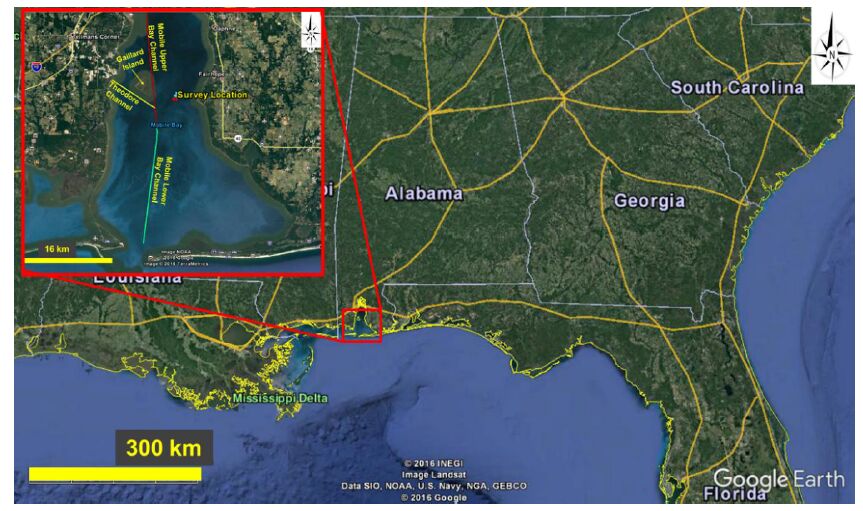
 DownLoad:
DownLoad: 